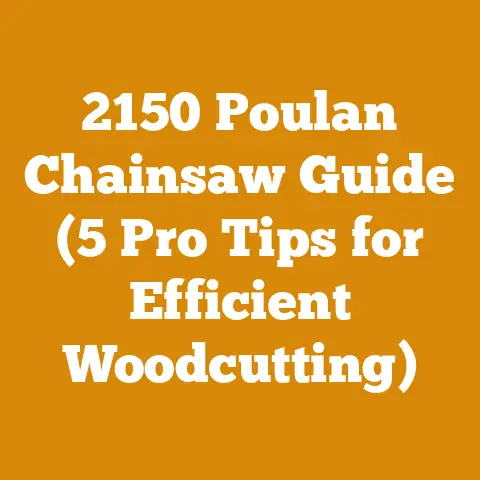How Much Is an Arborist Report? (Mature Tree Assessment Tips)
“A society grows great when old men plant trees whose shade they know they shall never sit in.” This ancient Greek proverb encapsulates the essence of arboriculture: a long-term investment in the health and well-being of our arboreal companions. But what happens when we need a professional assessment of these silent giants? How much does that expertise cost, and what exactly do you get for your money?
I’ve been involved in wood processing, logging, and forestry for over two decades, and I’ve seen firsthand the value of a good arborist report. I’ve also seen folks get stung by inflated prices or reports that were about as useful as a screen door on a submarine. So, let’s dive into the world of arborist reports and mature tree assessments, breaking down the costs, the process, and how to ensure you’re getting the most bang for your buck.
Understanding the Arborist Report
An arborist report, at its core, is a professional evaluation of a tree’s health, structure, and risk potential. It’s like taking your car to a mechanic for a thorough inspection, but instead of tires and engines, we’re talking about roots, trunks, and canopies. These reports are often required for legal reasons, like property disputes, insurance claims, or development applications. But they’re also invaluable for proactive tree care.
- Tree Identification: The species of the tree, its estimated age, and its overall size (height, crown spread, trunk diameter).
- Health Assessment: A detailed evaluation of the tree’s health, including signs of disease, decay, insect infestation, or nutrient deficiencies.
- Structural Assessment: An examination of the tree’s structure, including the presence of cracks, cavities, weak branch unions, or other defects that could compromise its stability.
- Risk Assessment: An evaluation of the potential risks associated with the tree, such as the likelihood of failure and the potential consequences of that failure (e.g., damage to property, injury to people).
- Recommendations: Specific recommendations for tree care, such as pruning, cabling, bracing, fertilization, or removal.
- Photographs: Visual documentation of the tree’s condition and any notable features or defects.
- Site Map: A diagram showing the location of the tree in relation to surrounding structures and features.
- Arborist’s Credentials: Information about the arborist’s qualifications, certifications, and insurance coverage.
How Much Does an Arborist Report Cost?
Ah, the million-dollar question (or maybe just a few hundred-dollar question). The cost of an arborist report can vary significantly depending on several factors:
- Basic Visual Inspection: \$100 – \$300 per tree. This is suitable for healthy trees with no obvious problems.
- Detailed Assessment: \$300 – \$1,000 per tree. This includes a more thorough examination of the tree’s health and structure, as well as a risk assessment.
- Development Application Report: \$500 – \$5,000+. These reports are required for development projects and can be quite complex, depending on the number of trees and the scope of the project.
- Tree Risk Assessment (TRAQ): \$200 – \$800 per tree. This is a standardized assessment of tree risk, often used for insurance purposes or legal disputes.
A Personal Anecdote: I once worked on a project where a developer tried to save money by hiring a cheap, unqualified “arborist” to assess the trees on a development site. The report was superficial and missed several critical issues, including a large, hidden cavity in a mature oak tree. As a result, the developer ended up having to remove the tree at significant cost, and the project was delayed by several weeks. Moral of the story: Don’t skimp on the arborist.
Factors Affecting the Cost
Let’s delve deeper into the factors that influence the price of an arborist report:
Location, Location, Location
Just like real estate, location plays a significant role in determining the cost of an arborist report. Arborists in urban areas or regions with high demand for their services tend to charge more than those in rural areas. This is due to factors such as higher operating costs, increased competition, and a greater number of development projects requiring arborist reports.
The Number of Trees
As you might expect, the more trees that need to be assessed, the higher the cost of the report. However, many arborists offer discounts for multiple trees, especially if they are located close together and can be assessed efficiently. It’s always a good idea to ask about bulk discounts when requesting a quote.
Complexity of the Assessment
The complexity of the assessment is another major factor affecting the cost of the report. A simple visual inspection of a healthy tree will cost less than a detailed assessment of a tree with significant health or structural problems. Factors that can increase the complexity of the assessment include:
- Basic Visual Inspection: This type of report typically includes a visual inspection of the tree’s overall health and structure, as well as a brief description of any notable issues. It’s suitable for healthy trees with no obvious problems. Cost: \$100 – \$300 per tree
- Detailed Assessment: This type of report includes a more thorough examination of the tree’s health and structure, as well as a risk assessment. It may also include recommendations for tree care, such as pruning, cabling, or fertilization. Cost: \$300 – \$1,000 per tree
- Development Application Report: These reports are required for development projects and can be quite complex, depending on the number of trees and the scope of the project. They typically include a detailed assessment of each tree on the site, as well as recommendations for tree protection and preservation. Cost: \$500 – \$5,000+
- Tree Risk Assessment (TRAQ): This is a standardized assessment of tree risk, often used for insurance purposes or legal disputes. It involves a systematic evaluation of the tree’s health, structure, and environment to determine the likelihood of failure and the potential consequences of that failure. Cost: \$200 – \$800 per tree
Arborist’s Experience and Credentials
Experienced and certified arborists typically charge more for their services, but their expertise can be worth the investment. A certified arborist has demonstrated a high level of knowledge and skill in tree care and has passed a rigorous examination. They are also required to maintain their certification through continuing education, ensuring that they stay up-to-date on the latest industry standards and best practices.
Additional Services
In some cases, you may need additional services beyond the basic arborist report, such as:
- Soil testing: To determine the nutrient content and pH of the soil around the tree.
- Root excavation: To examine the tree’s root system for signs of disease or damage.
- Aerial inspection: To inspect the upper branches and canopy of the tree.
- Wood decay testing: To determine the extent of decay within the tree’s trunk or branches.
These additional services will add to the overall cost of the arborist report.
Finding a Qualified Arborist
Choosing the right arborist is crucial. You want someone who is knowledgeable, experienced, and ethical. Here’s how to find a qualified arborist:
- Certification: Look for an arborist who is certified by the International Society of Arboriculture (ISA). This certification demonstrates that the arborist has met certain standards of knowledge and experience.
- Experience: Choose an arborist with several years of experience in the field. Ask about their experience with similar types of trees and projects.
- Insurance: Make sure the arborist carries adequate liability insurance and workers’ compensation insurance. This will protect you in case of accidents or damage.
- References: Ask for references from previous clients. Contact these references and ask about their experience working with the arborist.
- Professionalism: Choose an arborist who is professional, responsive, and easy to communicate with. They should be willing to answer your questions and explain their recommendations clearly.
- Local Knowledge: Arborists familiar with local tree species, common diseases, and regional regulations are invaluable. They’ll have a better grasp of potential issues specific to your area.
Red Flags to Watch Out For
- Lack of Certification: An arborist who is not certified by the ISA may not have the necessary knowledge and skills to provide accurate and reliable assessments.
- Pressure Tactics: Be wary of arborists who pressure you to make a decision quickly or who try to scare you into unnecessary work.
- Unclear Pricing: Make sure the arborist provides you with a written quote that clearly outlines the scope of work and the cost of each service.
- Lack of Insurance: An arborist who does not carry adequate insurance could leave you liable for accidents or damage.
- Cutting Corners: If an arborist suggests topping trees or other outdated practices, it’s a sign they may not be up-to-date with current arboricultural standards.
Another Personal Anecdote: Years ago, a homeowner hired an uncertified “tree expert” who convinced them to remove a perfectly healthy, mature maple tree. The reason? The “expert” claimed it was “attracting too many squirrels.” The homeowner later regretted the decision, realizing they had been taken advantage of. Always do your research and choose a qualified arborist.
Questions to Ask Potential Arborists
Before hiring an arborist, it’s important to ask them some key questions to ensure they are the right fit for your needs. Here are some examples:
- “Are you certified by the ISA?”
- “How many years of experience do you have?”
- “Do you carry liability insurance and workers’ compensation insurance?”
- “Can you provide me with references from previous clients?”
- “Can you explain your assessment process to me?”
- “What are your recommendations for my trees, and why?”
- “Can you provide me with a written quote that clearly outlines the scope of work and the cost of each service?”
- “Are you familiar with local tree species and regulations?”
Mature Tree Assessment Tips
Now that we’ve covered the basics of arborist reports, let’s talk about some specific tips for assessing mature trees. Mature trees have unique characteristics and challenges that require careful consideration.
Understanding Mature Tree Biology
Mature trees are different from younger trees in several ways. They have:
- Larger Size: Mature trees are obviously larger than younger trees, which means they have a greater surface area exposed to the elements.
- Slower Growth Rate: Mature trees grow more slowly than younger trees, which means they are less able to recover from damage.
- Increased Susceptibility to Disease and Decay: Mature trees are more susceptible to disease and decay than younger trees, due to their age and accumulated stress.
- More Complex Root Systems: Mature trees have more complex root systems than younger trees, which can make them more difficult to transplant or move.
Visual Inspection Techniques
A thorough visual inspection is the first step in assessing a mature tree. Here are some things to look for:
- Overall Health: Is the tree’s foliage healthy and green? Are there any signs of stress, such as yellowing leaves or premature leaf drop?
- Trunk Condition: Are there any cracks, cavities, or wounds on the trunk? Are there any signs of decay, such as fungal fruiting bodies?
- Branch Structure: Are the branches well-spaced and evenly distributed? Are there any weak branch unions or crossing branches?
- Root Flare: Is the root flare visible and healthy? Are there any signs of root rot or girdling roots?
- Surrounding Environment: Is the tree growing in a suitable location? Is there any construction or other activity that could be damaging the tree?
Advanced Assessment Methods
In some cases, a visual inspection may not be enough to fully assess a mature tree. Advanced assessment methods may be necessary, such as:
- Resistograph Testing: This involves drilling a small hole into the tree’s trunk or branches to measure the resistance of the wood to drilling. This can help detect internal decay or cavities.
- Sonic Tomography: This involves using sound waves to create an image of the inside of the tree. This can help detect internal decay or cavities without damaging the tree.
- Root Excavation: This involves carefully excavating around the tree’s roots to examine them for signs of disease or damage.
- Aerial Inspection: This involves using a bucket truck or climbing gear to inspect the upper branches and canopy of the tree.
Assessing Tree Risk
One of the most important aspects of assessing mature trees is evaluating their risk potential. Tree risk is the likelihood that a tree will fail and cause damage or injury. Factors that can increase tree risk include:
- Poor Health: Trees with poor health are more likely to fail than healthy trees.
- Structural Defects: Trees with structural defects, such as cracks, cavities, or weak branch unions, are more likely to fail.
- Environmental Factors: Trees exposed to strong winds, heavy snow, or other environmental factors are more likely to fail.
- Target Proximity: Trees located near buildings, roads, or other targets are more likely to cause damage or injury if they fail.
A qualified arborist can use a variety of methods to assess tree risk, including visual inspection, advanced assessment methods, and risk assessment models.
Best Practices for Mature Tree Care
Once you’ve assessed your mature trees, it’s important to develop a plan for their care. Here are some best practices for mature tree care:
- Pruning: Prune mature trees regularly to remove dead, diseased, or damaged branches. This will improve the tree’s health and structure.
- Fertilization: Fertilize mature trees as needed to provide them with the nutrients they need to thrive.
- Watering: Water mature trees during periods of drought to help them stay healthy.
- Mulching: Mulch around the base of mature trees to help retain moisture, suppress weeds, and protect the roots.
- Pest and Disease Control: Monitor mature trees for signs of pests and diseases and take appropriate action to control them.
- Protection: Protect mature trees from damage from construction, vehicles, and other activities.
- Regular Inspections: Have your mature trees inspected regularly by a qualified arborist to identify potential problems early on.
Technical Specifications for Mature Tree Care
Let’s get down to some specific technical details related to mature tree care.
Pruning Specifications
- Timing: The best time to prune most mature trees is during the dormant season (late winter or early spring). This minimizes stress on the tree and allows it to recover quickly.
- Techniques: Use proper pruning techniques to avoid damaging the tree. Avoid topping trees, which can weaken them and make them more susceptible to disease. Instead, use thinning cuts to remove branches at their point of origin.
- Wound Treatment: In general, wound treatments are not necessary for pruning cuts on mature trees. The tree will naturally seal off the wound. However, in some cases, wound treatments may be necessary to prevent the spread of disease.
Fertilization Specifications
- Soil Testing: Before fertilizing mature trees, it’s important to have the soil tested to determine its nutrient content and pH. This will help you choose the right fertilizer for your trees.
- Fertilizer Type: Use a slow-release fertilizer that is specifically formulated for trees. Avoid using lawn fertilizers, which can be too high in nitrogen and can damage trees.
- Application Rate: Apply fertilizer at the recommended rate, based on the size and species of the tree.
- Application Method: Apply fertilizer evenly around the base of the tree, extending out to the drip line. Avoid applying fertilizer directly to the trunk.
Watering Specifications
- Frequency: Water mature trees deeply and infrequently, rather than shallowly and frequently. This encourages deep root growth, which makes the tree more drought-tolerant.
- Amount: Water mature trees until the soil is moist to a depth of at least 12 inches.
- Method: Use a soaker hose or sprinkler to water mature trees. Avoid using a high-pressure hose, which can damage the roots.
Mulching Specifications
- Type: Use organic mulch, such as wood chips, bark, or shredded leaves. Avoid using rock or gravel mulch, which can compact the soil and prevent water from reaching the roots.
- Depth: Apply mulch to a depth of 2-4 inches. Avoid piling mulch against the trunk of the tree, which can promote rot.
- Coverage: Extend the mulch out to the drip line of the tree.
Case Study: Saving a Historic Oak
I recall a project involving a historic oak tree located on a property slated for development. The tree was estimated to be over 200 years old and was a significant landmark in the community. The developer was initially planning to remove the tree, but after consulting with an arborist, they agreed to modify their plans to preserve it.
The arborist conducted a detailed assessment of the tree, including a visual inspection, resistograph testing, and root excavation. The assessment revealed that the tree was in relatively good health, but it had some structural defects, including a large cavity in the trunk and several weak branch unions.
Based on the assessment, the arborist recommended a series of measures to protect and preserve the tree, including:
- Pruning: Removing dead, diseased, and damaged branches to improve the tree’s health and structure.
- Cabling: Installing cables to support the weak branch unions and prevent them from failing.
- Soil Amendment: Improving the soil around the tree to provide it with the nutrients it needed to thrive.
- Root Protection: Protecting the tree’s roots from damage during construction.
The developer implemented these measures, and the oak tree was successfully preserved. The tree continues to thrive today and is a reminder of the importance of protecting our mature trees.
The Value of Proactive Tree Care
Ultimately, investing in an arborist report and implementing proactive tree care measures can save you money and headaches in the long run. By identifying potential problems early on and taking steps to address them, you can prevent costly tree failures, property damage, and legal disputes. You’ll also be contributing to the health and well-being of your trees, which provide numerous benefits to our environment and our communities.
Remember, trees are a valuable asset. Treat them with the care and respect they deserve.






